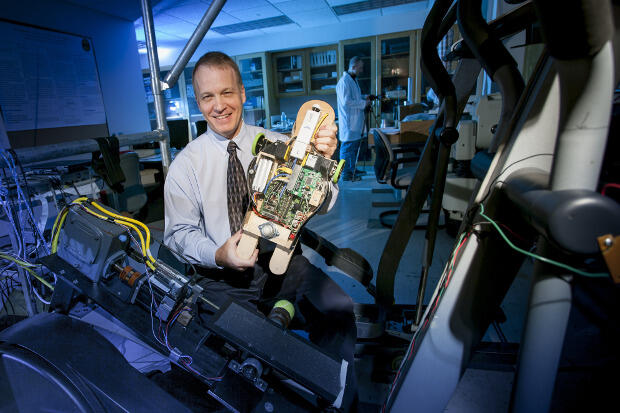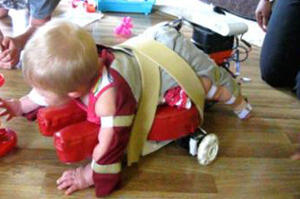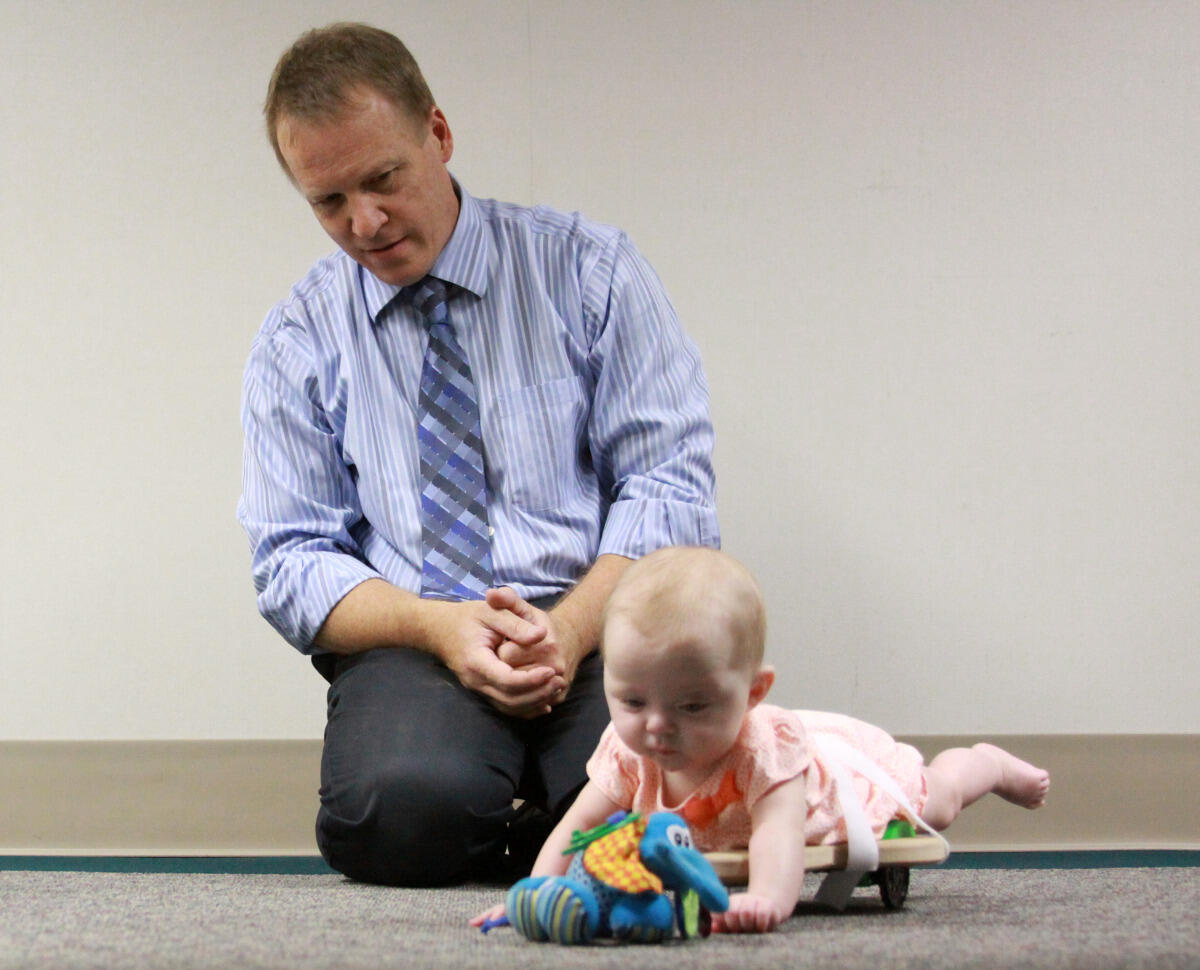
Sept. 11, 2015
Baby steps: Helping babies with neuromuscular disorders crawl and explore the world
Share this story
Three years ago in Oklahoma a mother, playing with her 8-month-old twin daughters, placed a toy on the ground. One of the sisters pulled herself to the toy while the other focused on it and moved her arms and legs, but got nowhere.
The situation wasn’t new to the mother. She already was aware of the reason one of her daughters was unable to crawl: She had cerebral palsy.
In many cases, children with cerebral palsy and other neuromuscular disorders are challenged by lack of coordination or lack of strength, preventing them from executing a coordinated crawling motion.
Overcoming this obstacle is important because there is more happening in a crawling baby’s brain than some might think. When children first begin to scoot, pull, slide and tug themselves from one curiosity to the next, they are discovering and grasping for knowledge, thus driving and promoting very critical cognitive and intellectual development during this early expression of inquisitiveness.
Kids who don’t explore and interact with their environments — who don’t go out and taste the objects and do all of the things that kids do — can have delayed cognitive development.
“Kids who don’t explore and interact with their environments — who don’t go out and taste the objects and do all of the things that kids do — can have delayed cognitive development,” said Peter Pidcoe, D.P.T., Ph.D., an associate professor and assistant chair in the Department of Physical Therapy, Virginia Commonwealth University School of Allied Health Professions. “There are age-critical benchmarks that need to be met in order to develop normally.”
This is the reality that one of the sisters in Oklahoma faced. Despite the fact that in her mind she could reach the toy, her muscles would not cooperate.
This dilemma is what brought Thubi Kolobe, Ph.D., a professor in the Department of Rehabilitation Sciences at the University of Oklahoma, to Pidcoe during a conference in 2004 in New Orleans.
Kolobe’s background was in pediatrics and she was involved in identifying infants who are likely to develop cerebral palsy or severe developmental delays in order to begin treatment for them as early as possible.
The problem at the time, however, was that available treatment was limited. Her solution was to tap into Pidcoe’s unique background in both engineering and physical therapy so that they could develop a novel way to promote movement in children who have cerebral palsy.
The birth of the SIPPC
“I was very involved with many infants who have cerebral palsy, and I saw them kicking and kicking and swiping their arms, but as they grew older they were losing these movements and falling more and more behind,” Kolobe said. “I felt like the intervention that would help these babies had to somehow, someway harness their early continuous movement and keep it going so they didn’t lose it.”
Pidcoe, who earned a clinical doctorate in physical therapy from VCU and also has a Ph.D. in biomedical engineering, was the perfect person to collaborate with Kolobe to integrate innovative technologies into a device that promotes developmentally appropriate movement.

“When Thubi came to me and said, ‘I want something to put under kids to harness and reinforce movement,’ I know how to do that,” Pidcoe said. “She gives me her clinical interpretation and I can translate that into engineering and write the code and make it work, which makes us a very powerful team.”
After speaking with Kolobe in New Orleans, Pidcoe soon was back in his VCU lab developing a prototype for a motorized skateboard-type platform that would move babies, lying on their stomachs, from point to point. It was clunky at first, “almost like the first portable computer — it was only portable because they put a handle on it,” he said, but it was a strong proof of concept.
Pidcoe and Kolobe were able to secure university, government and nonprofit grants that allowed the concept to be developed, revised and upgraded using a uniquely designed series of studies. The device was labeled the Self-initiated Prone Progressive Crawler, or SIPPC.
Mobility in infants is a gateway to learning.
“The most important thing was knowing this population,” said Kolobe. “Knowing the constraints and knowing what the infants would be able to tolerate was important because nobody had ever worked on crawling with babies this young, so we were going into uncharted territory.”
“On every iteration, and based on data collected from infants, we learned about better ways to do this, like making it lower to the ground and reducing motor capacity,” Pidcoe said. “In addition, as technology advanced, especially the reduction in the size and power consumption of drive components, the efficiency of the system improved.”
Pidcoe and Kolobe also worked on the SIPPC’s design to meet challenges presented by babies’ lack of head control, their breathing style and even their drooling propensity.
By 2008, Pidcoe and Kolobe had arrived at the sound design and shape the SIPPC holds today. They have also established three different modes for operation based on abilities of babies who might use it. These modes are as follows:
- Mobility mode: If the SIPPC detects any motion in any direction, it will continue to move in that direction for three seconds, providing motivation for the baby to make the SIPPC move again.
- Force (Kinetic) mode: A force plate on the SIPPC that the baby lies on measures shifts in weight, determines which direction the baby wants to move and moves in that direction.
- Sensor mode: Sensors that are mounted in a onesie-type suit that the child wears detect movement in the arms and legs, determine which way the baby wants to move and moves the SIPPC in predetermined directions.
“The idea behind the SIPPC is that we can invoke any of these three or a combination of these three to teach babies that movement is important and that it gets them where they want to go,” Pidcoe said.
On that day three years ago in Oklahoma, the girl who struggled to crawl was placed in the sensor-mode SIPPC as she had been for several previous months while participating in research for the device.
When placed on the SIPPC, the girl “would straighten her arms out like an airplane and bring them back in, and straighten them out again like an airplane, and finally get to the toy,” Kolobe said.
The sisters — one on the SIPPC and one crawling — would even compete with one another. They were racing to the toy, their mother said. It was a competition she never thought she would see.
“When I saw that, I thought, ‘This is exactly what we want the SIPPC to do. To harness their movement efforts and allow the infants to get to where they want to go,’” Kolobe said. “Mobility in infants is a gateway to learning.”
How it teaches

The SIPPC’s gateway to learning comes via reinforcement.
The SIPPC harnesses, in various ways, a child’s movements that couldn’t normally propel them due to lack of coordination or lack of strength. It then reinforces those movements by offering a reward in the form of advancing arbitrarily or toward a goal and eventual completion of that goal at some desired destination.
Learning to move the SIPPC happens slowly and by accident at first, but the babies do eventually repeat, “and if they repeat their arm and leg movements they don’t lose them,” Kolobe said. “That repetition builds the repertoire of movements needed for skills such as crawling and they get better at it.”
The process is tied to cognition, motor learning and neuroplasticity. The babies have to move intentionally in order to drive the SIPPC. Kolobe calls it a means to an endand explains that when babies understand they can use the SIPPC to attain their goals, that’s a cognitive skill.
“When babies are first introduced to the SIPPC they don’t do a whole lot — they can be surprised and even disturbed by the action,” Pidcoe said. “They have to practice, but once they do that, their exploration areas get larger and larger over time and the amount of time they spend moving in any session also increases.”
Translational science
Translating ideas and concepts into active treatments is a central goal for VCU, and a mechanism that enables that translation is VCU Innovation Gateway — a university resource that works with faculty to support the commercialization of university inventions and to promote research through collaborations and partnerships.
Through working with Innovation Gateway, Pidcoe and Kolobe have been nominated for the Smithsonian and U.S. Patent and Trademark Office 2015 Innovation Festival Sept. 26-27. It is one of many opportunities Innovation Gateway has secured for these investigators to present their prototype to investors and other universities.
Innovation Gateway has worked with their patent attorney, in collaboration with the University of Oklahoma’s Office of Technology Development, to direct patent filing and prosecution to ensure the SIPPC is adequately protected.
“That resource is very important for researchers like me because it protects the ideas that we develop here,” Pidcoe said. “And it’s translational research because, in my case, we’re working to get foundational neuroscience principals into clinical settings.”
I think what is gratifying about the SIPPC is knowing that these babies were capable all along.
“This partnership illustrates the mission of Innovation Gateway,” said Ivelina Metcheva, Ph.D., executive director of VCU Innovation Gateway. “We strive to foster a culture of innovation and to support our faculty’s valuable research by augmenting VCU inventions that can ultimately improve the quality of life in society.”
Pidcoe and Kolobe have shown in numerous carefully designed studies with infants with and without cerebral palsy that the SIPPC has the potential to be the kind of invention that does improve quality of life in larger society. The girl in Oklahoma was part of that research, and with the help of VCU Innovation Gateway, OU and VCU funding, and opportunities such as the 2015 Innovation Festival, the closer the project gets to realizing that potential.
“I think what is gratifying about the SIPPC is knowing that these babies were capable all along,” Kolobe said.
Subscribe to the weekly VCU News email newsletter at http://newsletter.news.vcu.
Subscribe to VCU News
Subscribe to VCU News at newsletter.vcu.edu and receive a selection of stories, videos, photos, news clips and event listings in your inbox.












